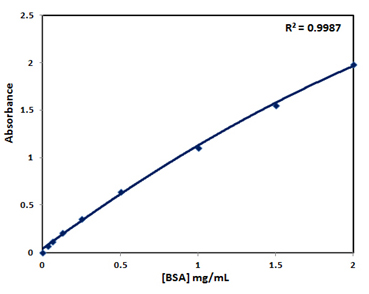The BCA Protein Assay Kit is a two-component, high-precision, detergent-compatible assay reagent set to measure total protein concentration compared to a protein standard. The BCA Protein Assay Kit is based on the formation of a Cu2+-protein complex under alkaline conditions, followed by reduction of the Cu2+ to Cu1+ by cysteine, cystine, tryptophan, tyrosine, and peptide bonds. BCA forms a purple colored complex with Cu1+ that is detectable at 562nm, and proportional to the protein present. The BCA Protein Assay can be used to assess yields in whole cell lysates and affinity-column fractions, as well as to monitor protein contamination in industrial applications. Compared to most dye-binding methods, the BCA Assay is affected much less by protein compositional differences, providing greater protein-to-protein uniformity.
| Protocol (PDF): | P011 |
| MSDS (PDF): | MSDS-P011 |
| COA (PDF): | COA-P011 |
Cited Reference:
Bergamottin reduces liver damage by suppressing inflammation, endoplasmic reticulum and oxidative stress in cafeteria diet-fed mice
E Yazici, E Sahin, E Alvuroglu, E Yulug, A Mentese
Food Bioscience, 2023, 52, 102371. https://doi.org/10.1016/j.fbio.2023.102371
Acetylbritannilactone attenuates contrast-induced acute kidney injury through its anti-pyroptosis effects.
Fei Chen, Jingchao Lu, Xiuchun Yang, Bing Xiao, Huiqiang Chen, Weina Pei, Yaqiong Jin, Mengxiao Wang, Yue Li, Jie Zhang, Fan Liu, Guoqiang Gu, Wei Cui
Biosci Rep 2020; 40 (2): BSR20193253. doi: https://doi.org/10.1042/BSR20193253
Fusobacterium nucleatum Causes Microbial Dysbiosis and Exacerbates Visceral Hypersensitivity in a Colonization-Independent Manner
Gu X, Song L, Li L, Liu T, Zhang M, Li Z, Wang P, Li M and Zuo X
Front. Microbiol. 2020, 11:1281. doi: 10.3389/fmicb.2020.01281
TRIM31 enhances chemoresistance in glioblastoma through activation of the PI3K/Akt signaling pathway
Fan MD, Zhao XY, Qi JN, Jiang Y, Liu BY, Dun ZP, Zhang R, Wang CW and Pang Q
Exp Ther Med 20: 802-809, 2020. https://doi.org/10.3892/etm.2020.8782
Probiotic Interventions Alleviate Food Allergy Symptoms Correlated with Cesarean Section: A Murine Model
Jin B-Y, Li Z, Xia Y-N, Li L-X, Zhao Z-X, Li X-Y, Li Y, Li B, Zhou R-C, Fu S-C, Li S-Y and Li Y-Q
Front. Immunol. 2021, 12:741371. doi: 10.3389/fimmu.2021.741371
Tilapia skin peptides, a by-product of fish processing, ameliorate DSS-induced colitis by regulating inflammation and inhibiting apoptosis
Gao J, Li L, Zhao D, Wang X, Xia Y, Li B, Liu C and Zuo X
Front. Nutr. 2022, 9:988758. doi: 10.3389/fnut.2022.988758
Hsa_circ_0001021 regulates intestinal epithelial barrier function via sponging miR-224-5p in ulcerative colitis
Bing Li, Yan Li, Lixiang Li, Yu Yu, Xiang Gu, Chang Liu, Xin Long, Yanbo Yu & Xiuli Zuo
EPIGENOMICS, 2021, 13, 17. https://doi.org/10.2217/epi-2021-0230
Chemical characterization, gastrointestinal motility and sensory evaluation of dark chocolate: A nutraceutical boosting consumers' health
Caponio, G.R.; Lorusso, M.P.; Sorrenti, G.T.; Marcotrigiano, V.; Difonzo, G.; De Angelis, E.; Guagnano, R.; Ciaula, A.D.; Diella, G.; Logrieco, A.F.; Montagna, M.T.; Monaci, L.; De Angelis, M.; Portincasa, P.
Nutrients 2020, 12(4), 939; https://doi.org/10.3390/nu12040939
Antimicrobial and Anticancer Activity of Corydalis solida
Dulger G.
Saglık Bilimlerinde Deger. 2022; 12(3): 534-539. https://doi.org/10.33631/sabd.1145694

